Purchasing climbing shoes isn’t the most straightforward task. Climbing shoes come in all sorts of shapes, sizes, comfort levels, and lacing systems. Which means, there are a lot of factors to consider when looking for the perfect climbing shoes for you. This is especially true if you’re looking for your first pair, since buying a pair that doesn’t suit you will likely ruin your climbing experience. And if you were to ask climbers for their advice, you’ll often get varying opinions. Hardcore climbers will tell you to look for aggressive shoes that are two sizes too small. More casual climbers will tell you to buy a cheap and comfortable pair. It can be a confusing ordeal to say the least. So to help you in your search, here are 5 questions to ask yourself before buying climbing shoes and our best answers for them.
5 Questions to Ask Yourself Before Buying Climbing Shoes
What Type of Climbing Will I Be Doing?
There are different styles of climbing you should be aware of, the most popular being bouldering, sport climbing, and trad climbing. Not to mention, there are specialized styles of climbing such as crack and slab climbing. What type of shoes you’ll need will be heavily influenced by the type of climbing you intend to do. Let’s talk a little about each.
Bouldering
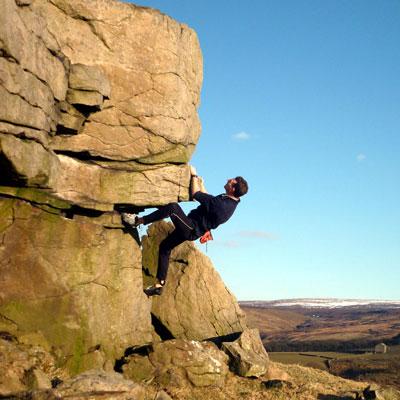 What is it?
What is it?
No rope. No harness. Short climbs under 20 ft. tall. Frequent breaks in-between attempts.
What’s good?
Aggressive, downturned shoes will be necessary once climbs become steeper or more overhung, but it’s a good idea to start with flat-soled shoes starting out. Slip-ons and velcro are perfect for bouldering as they are easy to slip on and off. Velcro offers the best performance and a snug to tight fit is recommended.
Sport
What is it?
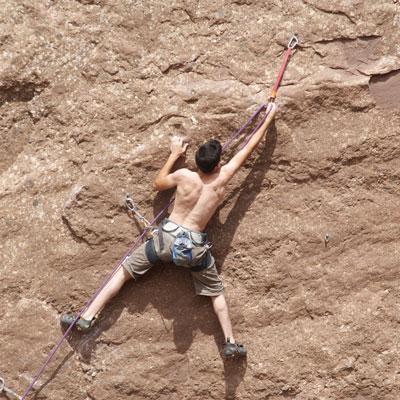 Harness and rope, check. Clip into quickdraws or other protection as you progress. Rely exclusively on strength and endurance.
Harness and rope, check. Clip into quickdraws or other protection as you progress. Rely exclusively on strength and endurance.
What’s good?
Velcro, laces, or slippers all work well, but laces offer the best fit. You’ll want a comfortable shoe that offers high performance that can last you a pitch or two. So, look for either a cambered or downturned toe that won’t have you writhing in pain as you climb.
Trad
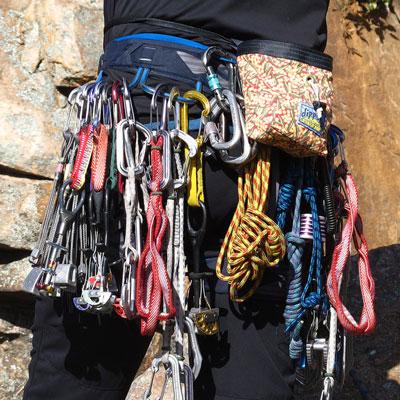 What is it?
What is it?
Type of lead climbing; place your own protection (gear) as you move up. Routes are often long but more laid back. Multi-pitch is climbing multiple long routes in succession.
What’s good?
Velcro, laces, or slip-ons can all be used. Shoes should also be very comfortable (especially if for all-day), durable, and flat-soled. It’s okay if they’re a bit loose as well, you can always wear some socks with them.
Crack
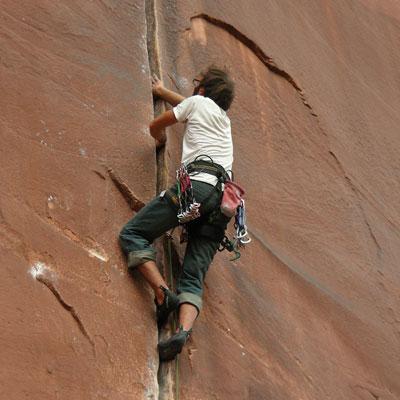 What is it?
What is it?
Jam your hands, fingers, toes, any body part really, into a crack to progress.
What’s good?
A flat and soft shoe works best. Rubber should be thick too. You’ll want to be able to fit your toes into cracks and the rubber should be able to conform to it nicely, so size them snug. Slip-ons are arguably the best for this style although you can use velcro or laces if it doesn’t cause any pain.
Slab
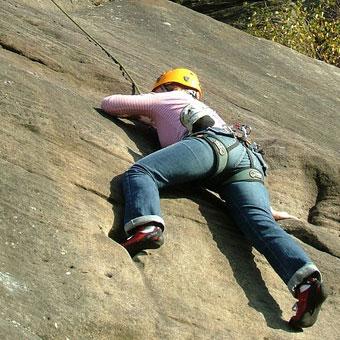 What is it?
What is it?
Climbing less than vertical walls on very small or no footholds. Lots of balance, smearing, and leg power required.
What’s good?
Slippers, velcro, or laces can all be used. But what you’ll want is a sensitive and relatively soft rubber to really be able to dig into the rock. Flat soles work the best for slab.
What Foot Shape Do I Have?
Next, you’ll need to find out what your foot shape is.
First off, do you have a wide or narrow foot? There are certain shoe brands that cater to a foot of smaller width, while others fit wide feet well. For example, La Sportiva generally makes shoes with a narrower profile, while Scarpa has a few shoes that are larger in the toebox area. You can see in the picture below that the La Sportiva Solution is a bit narrower than the Scarpa Instinct VS, which could be all you need to feel secure. Your feet should not be too scrunched up or have too much room that they are able to wiggle around.
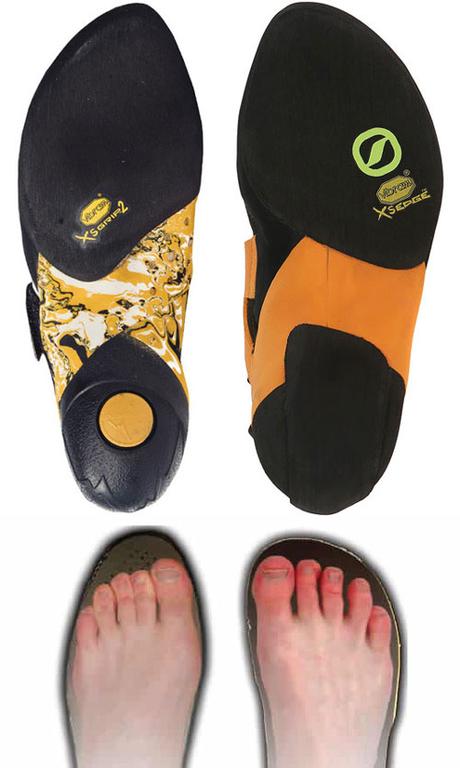
You’ll also want to take into account the size of your foot. No, not your size length-wise or width-wise, but height-wise. Meaning, what is the volume of your foot? Your foot needs to fill in all the space in a pair of climbing shoes, with no gaps or empty space present. Someone with a high volume foot should look for a shoe with a deep heel cup that doesn’t cause pain in the forefoot or midfoot. Most climbing shoes are built around high volume feet. However, those with low volume feet should look for a shoe with a smaller heel cup that isn’t too loose in the forefoot or midfoot. Evolv and La Sportiva make some climbing shoes that accommodate low volume feet, which are often the women’s version of shoes.
The prime focus when finding the right climbing shoes is to fit them snug (unless you do trad or multi-pitch) in order for them to provide the best performance. That means you’ll want your shoes to fit snug width-wise and volume-wise.
Do I Want Comfort or Performance?
There’s typically a correlation that high performance shoes are more painful while more comfortable shoes provide less performance. For the majority of shoes, this seems to be the case. That’s because high performance shoes are aggressive that they position the toe downwards. This can be quite uncomfortable to walk on (you shouldn’t be walking in climbing shoes anyway) and can take some time to get used to. On the other hand, comfortable shoes often have flat soles, which doesn’t cause any pain when walking or climbing.
Most people starting out climbing look for comfortable shoes above all else. Most experienced climbers would advise this as well. And this is generally sage advice for the majority of new climbers. A shoe that is comfortable, durable, and fits well is all you really need to learn the ropes of climbing.
However, some people may want to start off with shoes that offer higher performance, which is perfectly fine. I know when I started climbing, I was already looking for a shoe with more performance after the first month. My second pair of shoes had a cambered toe which helped me edge and climb overhangs better. A few months in, I already had a super aggressive shoe.
For performance shoes, it really depends on where you stand in climbing though. Do you think you will advance fairly quickly? Will you be climbing frequently (3-5x a week)? Are you already quite fit or have done calisthenics before? Can you stand a shoe that feels uncomfortable or even painful? If the answer to any of these questions is yes, a performance shoe could be a viable choice for you.
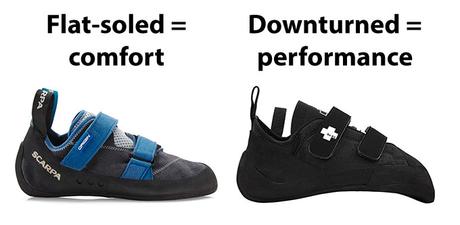
What’s My Budget?
Of course, the question of how much you are willing to spend should play a part in the shoe buying process as well. It’s just like purchasing any pair of shoes, really, although you should be a little more finicky when selecting athletic shoes. This is especially true if it’s your first pair of climbing shoes. Should you spend a ton of money on the best pair of climbing shoes available in hopes that it’ll allow you to climb better, quicker? Or, should you spend as little as humanly possible since you don’t know if you’ll continue climbing for long? Our suggestion is… neither.
Our best advice is to spend somewhere in the middle for the best of both worlds. On the one hand, you won’t want a cheap pair of shoes that offer poor performance and durability. Oftentimes, cheap shoes fall apart very quickly which means you’ll likely have to buy twice. On the other, you really don’t need a super expensive shoe with all the latest and greatest technology since you won’t make much use of it starting out. It’s just a waste of money in all honesty. A quality pair of shoes that offer good performance is more than enough for your first pair.
Is Climbing Really For Me?
Yes.

